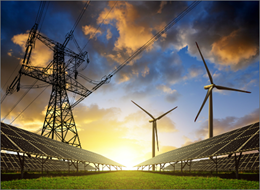-

Energy conservation has become a trending topic all around the world, and Singapore’s industrial sector cannot stay away from this so easily as this nation puts so much weight on sustainability. What has Singapore done to conserve energy? From using less carbon-intensive fuels to reduce greenhouse gas emissions to switching to natural gas to generate electricity, their commitment is quite impressive! However, there are many other initiatives they can easily implement technologically if they want to make it a smart manufacturing grid. What is the energy strategy of Singapore?
-

Thailand’s energy authorities are preparing to make an electricity saving campaign a mandate for households and businesses as they struggle to deal with the high prices of liquefied natural gas (LNG) which may keep soaring in the winter, putting more financial burden on national power generation, reported the Bangkok Post.
-

The economic downturn caused by Covid-19 pandemic has affected the supply-demand balance of liquefied natural gas (LNG) in the short and medium term. But in the near future, what will this "noble" fuel look like in the energy system of Vietnam?
-

Khí tự nhiên (natural gas) trộn với hydrogen được xem là “hỗn hợp xanh” (green mix) và thế giới đặt rất nhiều kỳ vọng vào tốc độ phát triển của nó.
-

UPS has announced it will supply its fleet in Memphis, Tenn., and Jackson, Miss., with an estimated 15 million diesel gallon gas equivalents of renewable natural gas (RNG) as part of a multi-year agreement with Memphis Light, Gas and Water and Atmos Energy Marketing.
-

Two alternative energy companies now are teaming with Smithfield Foods to convert gas from animal waste into renewable energy.
-

A team of researchers, including Kyle Brinkman of Clemson University, developed a material that acts as a superhighway for ions. The material could make batteries more powerful, change how gaseous fuel is turned into liquid fuel and help power plants burn coal and natural gas more efficiently.
-

Most of the world's electricity-producing power plants -- whether powered by coal, natural gas, or nuclear fission -- make electricity by generating steam that turns a turbine.
-

A natural gas development platform in the Gulf of Thailand, operated by Carigali-PTTEPI Operating Company Sdn. Bhd. (CPOC), has saved $52 million per year and significantly reduced water usage and chemical consumption with help from General Electric’s advanced cooling and chemical treatment technology.
-

Rather than rely on an electric utility to burn more coal or natural gas to provide electricity, as well as its own boilers to burn more fuel to provide heat, the facility decided to install a combined heat and power (CHP) unit.
-

In an average year, the demand would have been around 12.5 cubic meters of natural gas equivalents, but that's still less than half compared to the 27 cubic meters which is the reference for energy-efficient tomato cultivation in practice. Still, the standard for tomato cultivation is between 33 to 38 cubic meters.
-

Findings show carbon pollution from power plants can be cut cost-effectively by using wind, solar and natural gas
-

Solar power holds the promise of clean, limitless energy, but it currently suffers from high costs and an inherent disadvantage of not working when the sun isn't shining.
-

Energy generation from wind is on target to beat natural gas in 2012, thanks to a mad dash by wind producers to finish projects, as the wind tax credit is set to expire on January 1st.
-

The United States may become almost self-sufficient in terms of oil and natural gas by 2035, a report from the International Energy Agency states.
-

Solar-powered electricity prices could soon approach those of power from coal or natural gas thanks to collaborative research with solar start-up Ampulse Corporation at the U.S. Department of Energy’s (DOE) National Renewable Energy Laboratory (NREL).
-

Porous crystals called metal-organic frameworks, with their nanoscopic pores and incredibly high surface areas, are excellent materials for natural gas storage.
-

That Sai Gon Passenger Transport Co., Ltd is allowed to borrow the State with the interest rate of 0% and exempted from the tax of importing 50 CNG buses has laid the foundation for the development of green buses in Vietnam.
-

As of 2010, 57% of electricity in Latin America and the Caribbean stems from hydro sources while another 40% comes from thermoelectric power plants using fossil fuels and natural gas. Of the remainder, 2% comes from nuclear stations and 1% from wind, solar and geothermal plants.
-

Compressed natural gas technology first appeared in Vietnam with the introduction of CNG natural gas plant in Phu My I Industrial Zone, Tan Thanh district, Ba Ria-Vung Tau, which began operation in late August 2008. In Nay 2010, to limit environmental pollution and reduce climate change, for the clean and green environment, Vietnam Oil and Gas Group of issued Resolution No. 2958/NQ-DKVN approving the conversion and use of CNG fuel for cars of all members of the group in the areas of HCM city and Ba Ria-Vung Tau (about 600 vehicles).




















 Energy efficiency and sustainable development in textile sector
Energy efficiency and sustainable development in textile sector
 Hoa Phat saves nearly 3,500 billion dong thanks to self-generated electricity
Hoa Phat saves nearly 3,500 billion dong thanks to self-generated electricity
 Enhancing capacity to develop and implement energy efficiency policies at local level
Enhancing capacity to develop and implement energy efficiency policies at local level
 Stanley Vietnam: Targeting a 4% Reduction in Annual Energy Consumption Intensity
Stanley Vietnam: Targeting a 4% Reduction in Annual Energy Consumption Intensity
 Nghe An Industrial Enterprises Proactively Implement Energy-Saving Measures
Nghe An Industrial Enterprises Proactively Implement Energy-Saving Measures
 WEBINAR 1 - Scaling Up Energy Efficiency in Vietnam
WEBINAR 1 - Scaling Up Energy Efficiency in Vietnam
 Bosch Vietnam Plant Benefits from Investment in Energy Efficiency
Bosch Vietnam Plant Benefits from Investment in Energy Efficiency